cooling PEUGEOT 4008 2017 Owners Manual
[x] Cancel search | Manufacturer: PEUGEOT, Model Year: 2017, Model line: 4008, Model: PEUGEOT 4008 2017Pages: 368, PDF Size: 12.22 MB
Page 28 of 368
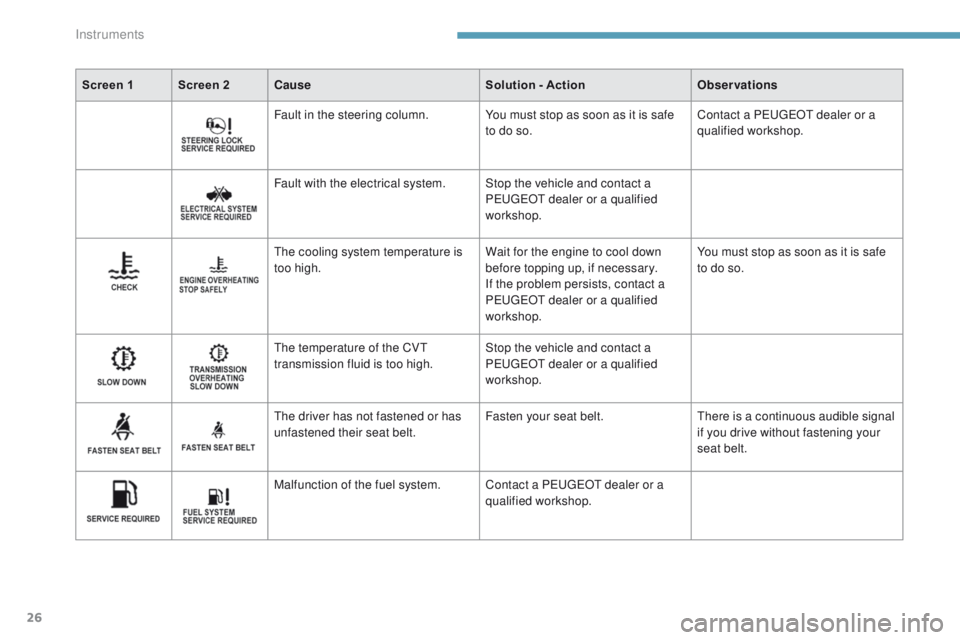
26
Screen 1 Screen 2Cause Solution - ActionObservations
Fault in the steering column. You must stop as soon as it is safe to do so.Contact a P
e
uge
Ot
dealer or a
qualified workshop.
Fault with the electrical system. Stop the vehicle and contact a P
e
uge
Ot
dealer or a qualified
workshop.
th
e cooling system temperature is
too high. Wait for the engine to cool down
before topping up, if necessary.
If the problem persists, contact a
P
e
uge
Ot
dealer or a qualified
workshop. You must stop as soon as it is safe
to do so.
th
e temperature of the CV
t
transmission fluid is too high. Stop the vehicle and contact a
P
e
uge
Ot
dealer or a qualified
workshop.
th
e driver has not fastened or has
unfastened their seat belt. Fasten your seat belt.
th
ere is a continuous audible signal
if you drive without fastening your
seat belt.
Malfunction of the fuel system. Contact a P
e
uge
Ot
dealer or a
qualified workshop.
Instruments
Page 37 of 368
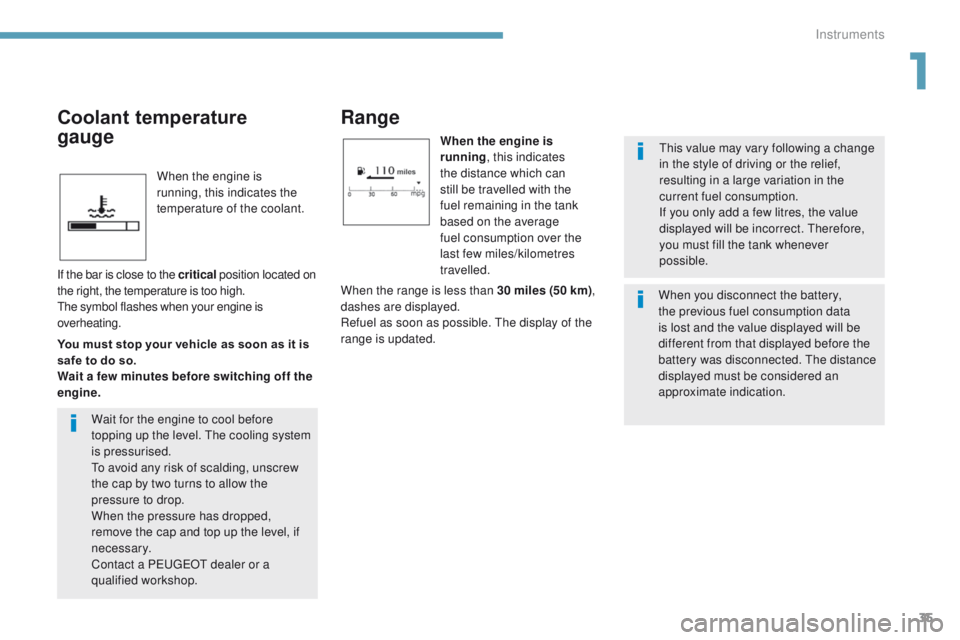
35
4008_en_Chap01_Instruments-de-bord_ed01-2016
When the engine is
running, this indicates the
temperature of the coolant.
Range
When the engine is
running, this indicates
the distance which can
still be travelled with the
fuel remaining in the tank
based on the average
fuel consumption over the
last few miles/kilometres
travelled.th is value may vary following a change
in the style of driving or the relief,
resulting in a large variation in the
current fuel consumption.
If you only add a few litres, the value
displayed will be incorrect.
t
h
erefore,
you must fill the tank whenever
possible.
Coolant temperature
gauge
If the bar is close to the critical position located on
the right, the temperature is too high.
the
symbol flashes when your engine is
overheating.
You must stop your vehicle as soon as it is
safe to do so.
Wait a few minutes before switching off the
engine. When the range is less than 30 miles (50 km)
,
dashes are displayed.
Refuel as soon as possible.
t
h
e display of the
range is updated.
Wait for the engine to cool before
topping up the level. th e cooling system
is pressurised.
to a
void any risk of scalding, unscrew
the cap by two turns to allow the
pressure to drop.
When the pressure has dropped,
remove the cap and top up the level, if
necessary.
Contact a P
e
uge
Ot
dealer or a
qualified workshop. When you disconnect the battery,
the previous fuel consumption data
is lost and the value displayed will be
different from that displayed before the
battery was disconnected.
t
h
e distance
displayed must be considered an
approximate indication.
1
Instruments
Page 81 of 368
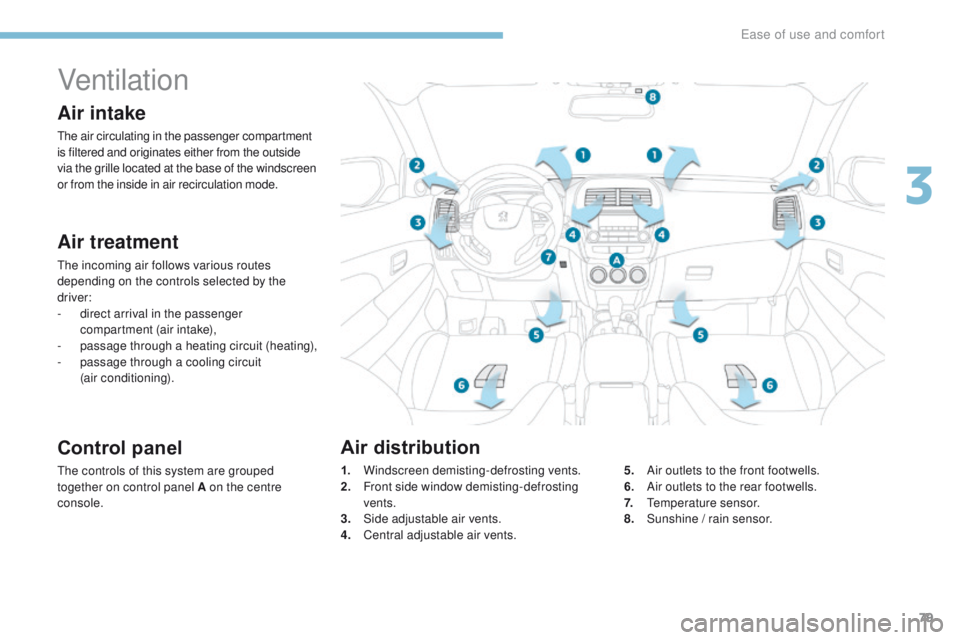
79
4008_en_Chap03_Ergonomie-et-confort_ed01-2016
Ventilation
Air intake
the air circulating in the passenger compartment
is filtered and originates either from the outside
via the grille located at the base of the windscreen
or from the inside in air recirculation mode.
Air treatment
the incoming air follows various routes
depending on the controls selected by the
driver:
-
d
irect arrival in the passenger
compartment (air intake),
-
p
assage through a heating circuit (heating),
-
p
assage through a cooling circuit
(air conditioning).
Control panel
the controls of this system are grouped
together on control panel A on the centre
console. 1. W
indscreen demisting-defrosting vents.
2. F ront side window demisting-defrosting
vents.
3.
S
ide adjustable air vents.
4.
C
entral adjustable air vents.5. A
ir outlets to the front footwells.
6. A ir outlets to the rear footwells.
7.
t
em
perature sensor.
8.
S
unshine / rain sensor.
Air distribution
3
ease of use and comfort
Page 85 of 368
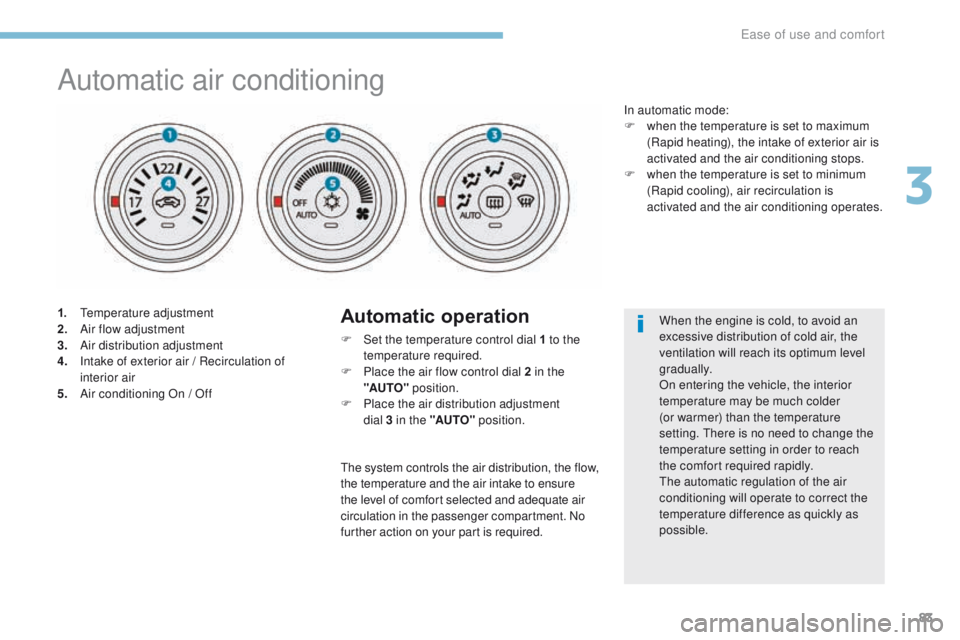
83
4008_en_Chap03_Ergonomie-et-confort_ed01-2016
Automatic air conditioning
1. temperature adjustment
2. Air flow adjustment
3.
A
ir distribution adjustment
4.
I
ntake of exterior air / Recirculation of
interior air
5.
A
ir conditioning On / OffAutomatic operation
F Set the temperature control dial 1 to the temperature required.
F
P
lace the air flow control dial 2 in the
"AUTO" position.
F
P
lace the air distribution adjustment
dial 3 in the "AUTO" position. When the engine is cold, to avoid an
excessive distribution of cold air, the
ventilation will reach its optimum level
gradually.
On entering the vehicle, the interior
temperature may be much colder
(or warmer) than the temperature
setting.
t
h
ere is no need to change the
temperature setting in order to reach
the comfort required rapidly.
th
e automatic regulation of the air
conditioning will operate to correct the
temperature difference as quickly as
possible.
In automatic mode:
F
w
hen the temperature is set to maximum
(Rapid heating), the intake of exterior air is
activated and the air conditioning stops.
F
w
hen the temperature is set to minimum
(Rapid cooling), air recirculation is
activated and the air conditioning operates.
th
e system controls the air distribution, the flow,
the temperature and the air intake to ensure
the level of comfort selected and adequate air
circulation in the passenger compartment. No
further action on your part is required.
3
ease of use and comfort
Page 180 of 368
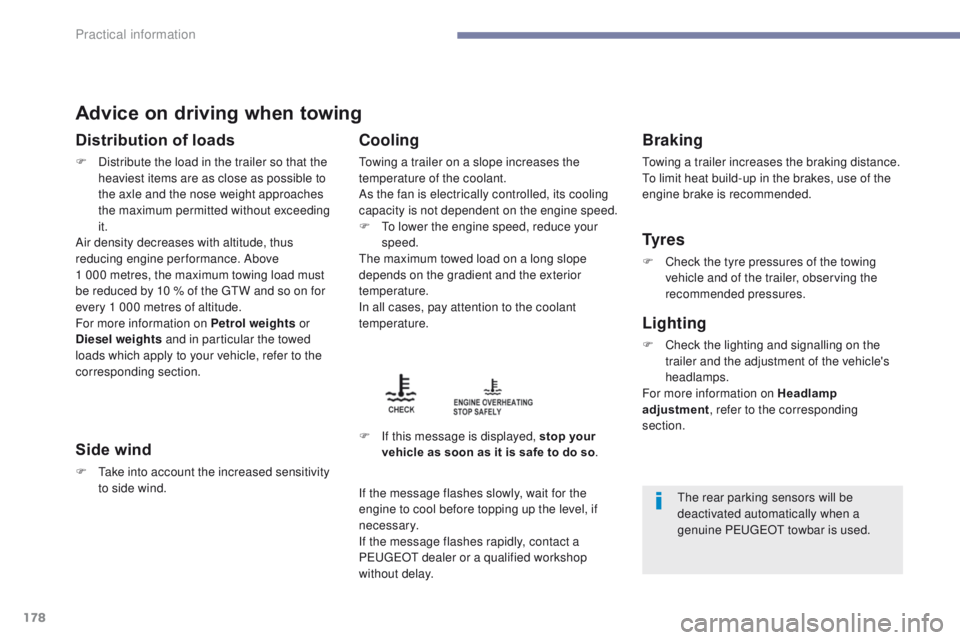
178
4008_en_Chap07_info-pratiques_ed01-2016
Advice on driving when towing
Distribution of loads
F Distribute the load in the trailer so that the heaviest items are as close as possible to
the axle and the nose weight approaches
the maximum permitted without exceeding
it.
Air density decreases with altitude, thus
reducing engine performance. Above
1
000 metres, the maximum towing load must
be reduced by 10
% of the gt
W a
nd so on for
every 1
000 metres of altitude.
For more information on Petrol weights or
Diesel weights and in particular the towed
loads which apply to your vehicle, refer to the
corresponding section.
Side wind
F take into account the increased sensitivity to side wind.
Cooling
towing a trailer on a slope increases the
temperature of the coolant.
As the fan is electrically controlled, its cooling
capacity is not dependent on the engine speed.
F
t
o l
ower the engine speed, reduce your
speed.
th
e maximum towed load on a long slope
depends on the gradient and the exterior
temperature.
In all cases, pay attention to the coolant
temperature.
F
I
f this message is displayed, stop your
vehicle as soon as it is safe to do so .
Braking
towing a trailer increases the braking distance.to l
imit heat build-up in the brakes, use of the
engine brake is recommended.
Ty r e s
F Check the tyre pressures of the towing vehicle and of the trailer, observing the
recommended pressures.
Lighting
F Check the lighting and signalling on the trailer and the adjustment of the vehicle's
headlamps.
For more information on Headlamp
adjustment , refer to the corresponding
section.
If the message flashes slowly, wait for the
engine to cool before topping up the level, if
necessary.
If the message flashes rapidly, contact a
P
e
uge
Ot
dealer or a qualified workshop
without delay.
the rear parking sensors will be
deactivated automatically when a
genuine P
e
uge
Ot
towbar is used.
Practical information
Page 182 of 368
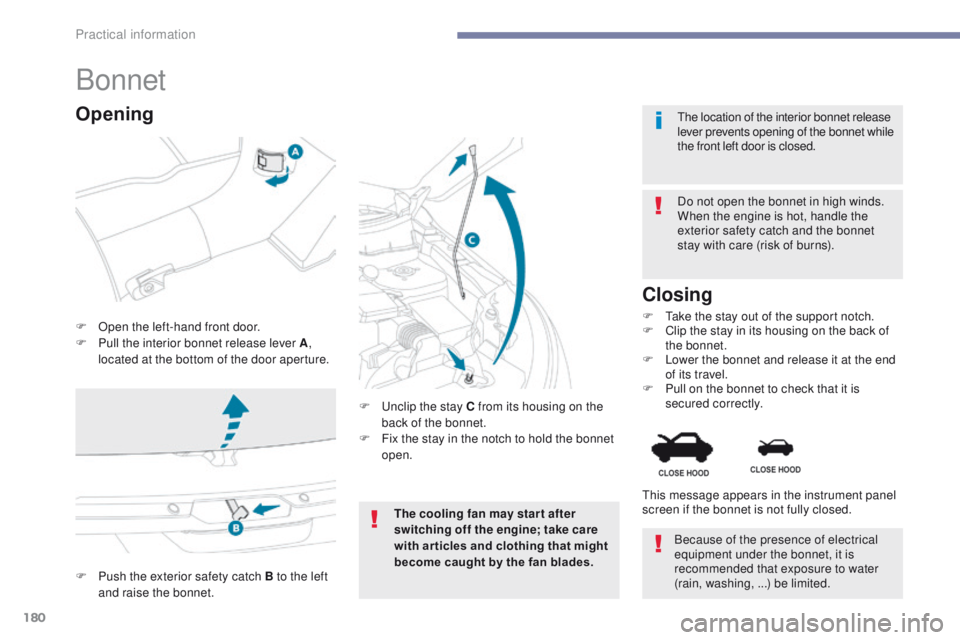
180
4008_en_Chap07_info-pratiques_ed01-2016
Bonnet
F Open the left-hand front door.
F P ull the interior bonnet release lever A ,
located at the bottom of the door aperture. Do not open the bonnet in high winds.
When the engine is hot, handle the
exterior safety catch and the bonnet
stay with care (risk of burns).
F u
n
clip the stay C from its housing on the
back of the bonnet.
F
F
ix the stay in the notch to hold the bonnet
open.
Closing
F take the stay out of the support notch.
F C lip the stay in its housing on the back of
the bonnet.
F
L
ower the bonnet and release it at the end
of its travel.
F
P
ull on the bonnet to check that it is
secured correctly.
th
e location of the interior bonnet release
lever prevents opening of the bonnet while
the front left door is closed.
Opening
F Push the exterior safety catch B to the left
and raise the bonnet.
th
is message appears in the instrument panel
screen if the bonnet is not fully closed.
The cooling fan may star t after
switching off the engine; take care
with ar ticles and clothing that might
become caught by the fan blades. Because of the presence of electrical
equipment under the bonnet, it is
recommended that exposure to water
(rain, washing, ...) be limited.
Practical information
Page 185 of 368
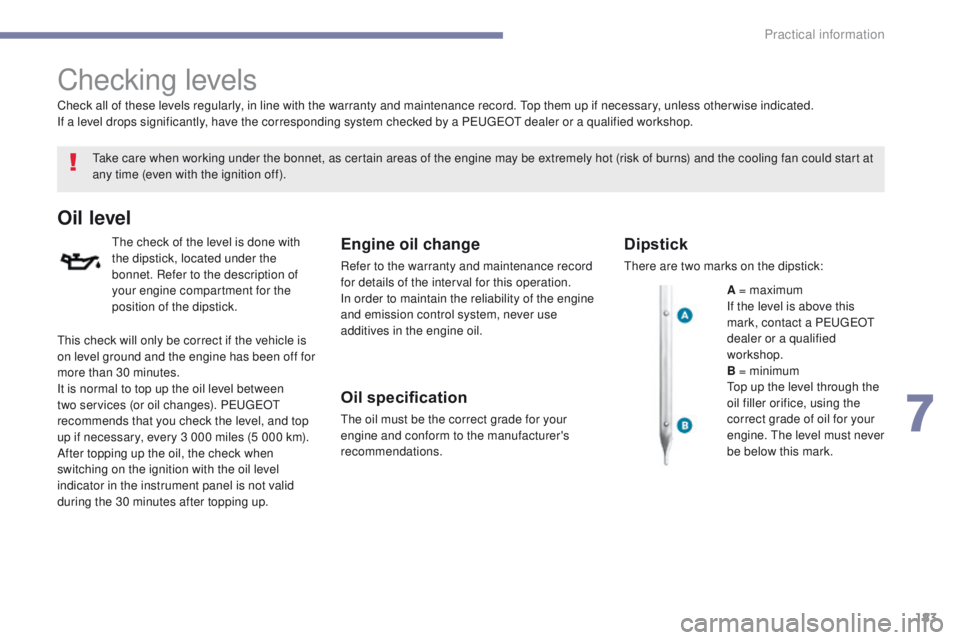
183
4008_en_Chap07_info-pratiques_ed01-2016
Checking levels
take care when working under the bonnet, as certain areas of the engine may be extremely hot (risk of burns) and the cooling fan could start at
any time (even with the ignition off).
Oil level
the check of the level is done with
the dipstick, located under the
bonnet. Refer to the description of
your engine compartment for the
position of the dipstick.Engine oil change
Refer to the warranty and maintenance record
for details of the interval for this operation.
In order to maintain the reliability of the engine
and emission control system, never use
additives in the engine oil.
Oil specification
the oil must be the correct grade for your
engine and conform to the manufacturer's
recommendations.
Check all of these levels regularly, in line with the warranty and maintenance record.
t
o
p them up if necessary, unless other wise indicated.
If a level drops significantly, have the corresponding system checked by a P
e
uge
Ot
dealer or a qualified workshop.
Dipstick
there are two marks on the dipstick:
A = maximum
If the level is above this
mark, contact a P
e
uge
Ot
dealer or a qualified
workshop.
B = minimum
to
p up the level through the
oil filler orifice, using the
correct grade of oil for your
engine.
t
h
e level must never
be below this mark.
th
is check will only be correct if the vehicle is
on level ground and the engine has been off for
more than 30 minutes.
It is normal to top up the oil level between
two services (or oil changes). P
e
uge
Ot
recommends that you check the level, and top
up if necessary, every 3 000 miles (5 000 km).
After topping up the oil, the check when
switching on the ignition with the oil level
indicator in the instrument panel is not valid
during the 30 minutes after topping up.
7
Practical information
Page 186 of 368
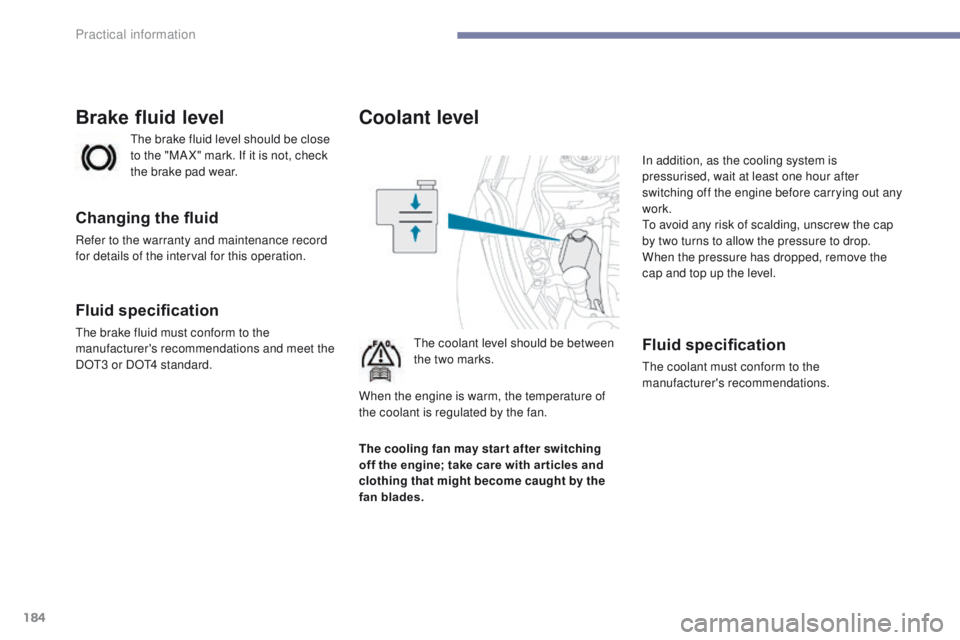
184
4008_en_Chap07_info-pratiques_ed01-2016
Coolant level
the coolant level should be between
the two marks.In addition, as the cooling system is
pressurised, wait at least one hour after
switching off the engine before carrying out any
work.
to a
void any risk of scalding, unscrew the cap
by two turns to allow the pressure to drop.
When the pressure has dropped, remove the
cap and top up the level.Fluid specification
the coolant must conform to the
manufacturer's recommendations.
th
e brake fluid level should be close
to the "MA X" mark. If it is not, check
the brake pad wear.
Brake fluid level
Changing the fluid
Refer to the warranty and maintenance record
for details of the interval for this operation.
Fluid specification
the brake fluid must conform to the
manufacturer's recommendations and meet the
DO
t3 o
r DO
t4 s
tandard.
The cooling fan may star t after switching
off the engine; take care with ar ticles and
clothing that might become caught by the
fan blades. When the engine is warm, the temperature of
the coolant is regulated by the fan.
Practical information